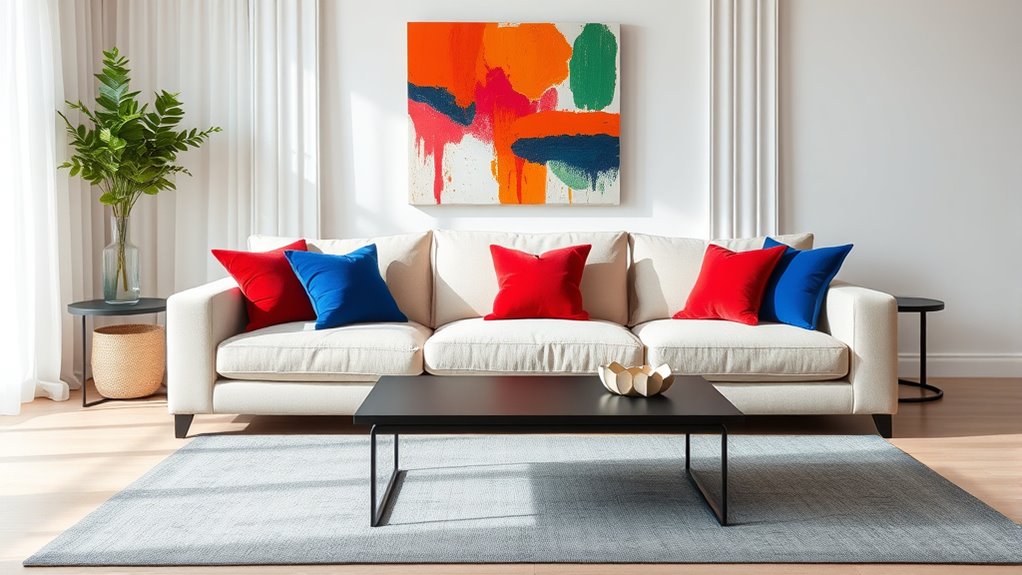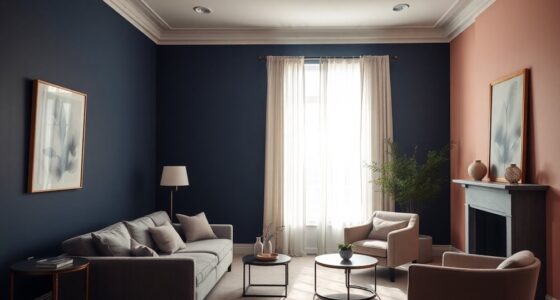To achieve visual harmony, balance bold colors with neutrals by using them as anchors and accents. Keep neutrals like beige, gray, or white as the dominant backdrop, allowing vibrant hues to serve as focal points or highlights. Pair warm tones with warm neutrals and cool shades with cool neutrals for a cohesive look. Incorporating textures and layered elements adds depth, ensuring your space feels lively yet calming. Continue exploring to discover how to create a perfectly balanced, stylish environment.
Key Takeaways
- Use neutral tones as the dominant background to allow bold colors to serve as focal points.
- Incorporate neutral accents like rugs, walls, or cushions to create visual resting places amidst vibrant hues.
- Pair warm bold colors with warm neutrals and cool bold shades with cool neutrals for harmonious contrast.
- Balance textures by combining smooth and textured neutral elements to add depth without overwhelming bold colors.
- Strategically place bold features as highlights, ensuring neutrals provide a calming, unifying backdrop.

When incorporating bold colors into your space, balancing them with neutral tones is essential for creating a harmonious look. Bold hues like vibrant reds, deep blues, or bright yellows can energize a room, but without proper balance, they might overwhelm the senses. To achieve a cohesive environment, focus on effective color pairing by mixing your statement colors with neutral accents. Neutral tones—such as beige, gray, white, or soft taupe—serve as a calming backdrop that grounds the more vivid elements, preventing your space from feeling chaotic or overstimulating.
Start by choosing your bold color as a focal point. Whether it’s a brightly colored accent wall or a statement piece of furniture, ensure that the surrounding decor incorporates neutral accents. These neutral elements act as visual anchors, giving your eye a place to rest amidst the intensity of the bold color. For example, if you opt for a striking emerald green sofa, balance it with neutral-colored throw pillows, curtains, or a rug. This technique creates a layered look that’s visually appealing without becoming overwhelming.
In terms of color pairing, think about how different hues interact with neutrals. Warm bold colors, like fiery reds or sunny yellows, work well with warm neutrals, such as tan or caramel tones. Conversely, cooler bold shades like royal blue or emerald green pair beautifully with cooler neutrals like gray or soft white. When you combine these, be deliberate about the proportion of neutral accents you introduce. A good rule of thumb is to keep neutral tones as the dominant background, allowing your bold colors to shine through as accent features. This ensures your space remains balanced and inviting.
Incorporating neutral accents can also involve textures and materials. A plush beige rug, sleek white walls, or matte gray furniture can all serve as understated neutral accents that complement your bold color choices. These elements add depth and interest without competing for attention, allowing the bold hues to pop in a natural and sophisticated way. When you mix textures—like a smooth satin cushion with a rough woven throw—you add richness and dimension, making your space feel more layered and thoughtfully curated.
Ultimately, balancing bold colors with neutral accents isn’t about suppressing your personality; it’s about creating a visually harmonious environment. By carefully considering color pairing and integrating neutral tones strategically, you can craft a room that’s lively yet balanced, energetic yet calming. Incorporating neutral tones as a fundamental design principle ensures your space remains welcoming and stylish, with bold colors acting as highlights rather than overwhelming features.
Frequently Asked Questions
How Do I Choose the Right Neutral Tones for Bold Colors?
To select the right neutral tones for bold colors, consider neutral undertones and color temperature. Opt for warm neutrals like beige or taupe if your bold color has warm undertones, and choose cool neutrals like gray or slate for cooler hues. Test samples in your space to see how they interact under different lighting. This guarantees your neutrals complement your bold colors, creating a balanced and harmonious look.
Can Bold Colors Work in Small Spaces Without Overwhelming?
Yes, bold colors can work in small spaces without overwhelming if you control the color saturation and create visual focal points. Use bold hues on accent walls or accessories, and keep surrounding areas neutral. This prevents the space from feeling cluttered. By strategically placing bold colors, you draw attention to specific areas, maintaining harmony and making your small space feel lively yet balanced.
What Accessories Best Complement Bold and Neutral Color Schemes?
You might think understated accessories would fade in a bold and neutral scheme, but ironically, statement jewelry and patterned textiles become your best allies. These pieces add just the right pop of excitement without overwhelming the space. Opt for chunky necklaces or vibrant throw pillows—tools that create visual interest and harmony. They draw the eye, complement your color palette, and turn your room into a lively yet balanced retreat.
How Do Lighting Choices Affect Color Balance in a Room?
Lighting choices greatly influence your room’s color balance. Natural light enhances true colors, making bold hues pop and neutrals feel warm. Artificial lighting, like warm or cool bulbs, can alter the mood and tone, either softening or intensifying colors. To achieve harmony, combine natural light with well-chosen artificial lighting, adjusting the brightness and color temperature to highlight your color scheme’s balance and create a welcoming, cohesive space.
Are There Seasonal Color Pairing Tips for Balancing Bold and Neutral Hues?
Think of your space as a garden that blooms differently each season. To create harmony, use a seasonal palette that guides your color progression—bright, lively hues in spring, warm, cozy tones in winter. Pair bold colors with neutrals thoughtfully, allowing them to stand out without overwhelming. In fall, earthy neutrals with jewel-toned accents work beautifully, while in summer, fresh, light shades balance bold statements for a seamless seasonal flow.
Conclusion
By balancing bold colors with neutrals, you create a space that’s vibrant yet calming, lively yet sophisticated. Think of it as a dance—each hue taking its turn, neither overpowering the other. When you master this harmony, your environment becomes a canvas of visual delight. So, embrace the contrast, let your personality shine through, and watch your space transform into a perfect symphony of color and calm—where every element sings in unity.









